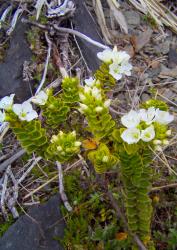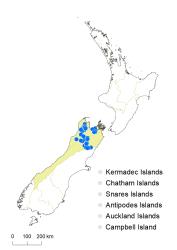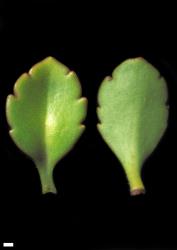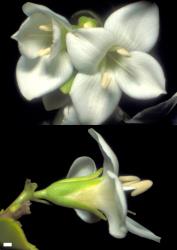- ≡ Hebe macrantha var. brachyphylla (Cheeseman) Cockayne & Allan, Trans. New Zealand Inst. 57: 43 (1926)
- ≡ Parahebe macrantha var. brachyphylla (Cheeseman) Heads, Bot. J. Linn. Soc. 115: 79 (1994)
Lamina elliptic to broadly elliptic, 7–15 (rarely 6–18) mm long, 5–10 (rarely 4–12) mm wide, widest point about halfway; teeth in 1–5 pairs; petiole 1–4 mm long. Peduncle 1.5–10.0 (rarely –13.0) mm long; lowermost bracts 2–4 (rarely –8) mm long; pedicels 0.5–3.0 mm long. Calyx lobes 5–8 mm long.
Plants of V. macrantha var. macrantha are distinguished from var. brachyphylla by narrower leaves that are mostly oblanceolate in shape and have more marginal teeth, and by their generally longer petioles, peduncles, lowermost inflorescence bracts, and calyx lobes. Identification is most likely to be difficult where the two varieties meet near Lake Tennyson. See Bayly et al. (2004) and Bayly & Kellow (2006) for more detailed information.
South Island: Western Nelson, Sounds Nelson, north Westland, Canterbury (north of about Lake Tennyson), west and south-west Marlborough.
Penalpine grassland and low shrubland. Recorded elevations range from 760 to 1646 m.
2n = 42 (see Bayly & Kellow 2006, as Hebe macrantha var. brachyphylla).







